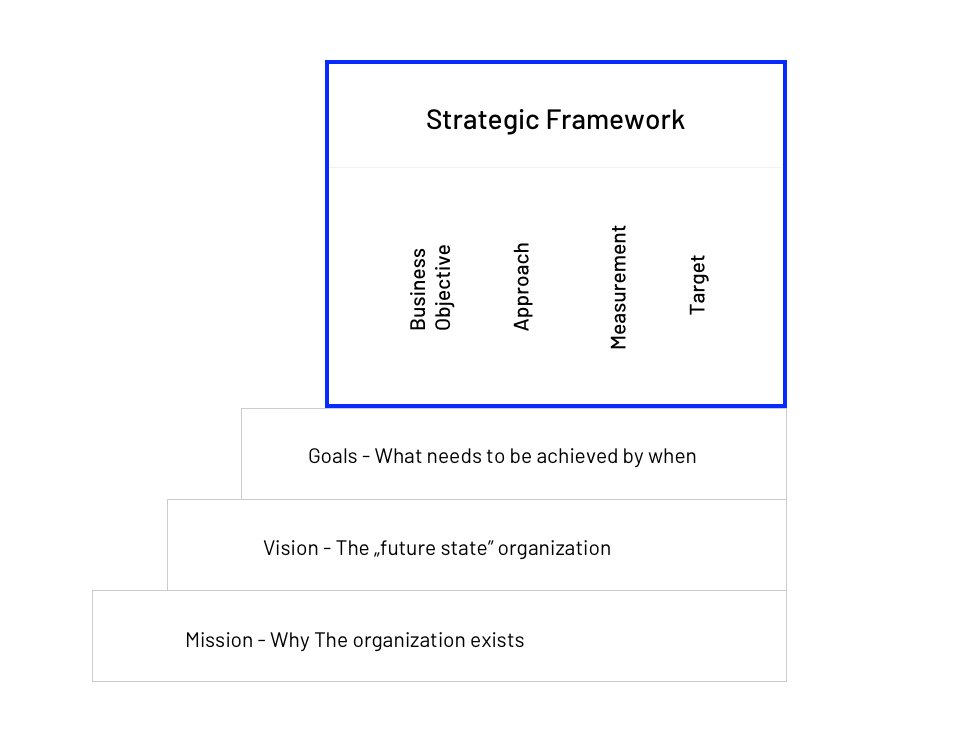Have you ever been a part of a team where the outcomes fell short of promises? Did you ever have a great idea that just didn’t get any execution or support from your coworkers? Were the goals and objectives of that good project clearly linked to the objectives of your company? Did you develop a strategic framework? In this article we will dive into strategic frameworks, which will help you with setting and achieving your business goals through strategic thinking.
Articles In This Series (all articles in this series will be added here):
- #1: How To Introduce Strategic Thinking In Project Management
- #2: Using Strategic Thinking To Analyze The Bigger Picture
- #3: How To Set Long And Short-Term Goals?
- #4: Tools And Frameworks To Help You Implement Your Strategy
What Is A Strategic Framework?
A strategic framework is a method used to define how a project supports the key objectives of a company. There are four required components to a strategic framework:
- Business objective. What will the project achieve?
- Approach. How will I deliver that achievement?
- Measurement. How will we measure and report our work?
- Target. What is the estimated improvement that will define success?
Do You Need To Be Using a Strategic Framework?
Strategic frameworks are great tools, but they aren’t necessary when it comes to developing and executing strategy. If you have a problem with coming up with an effective set of goals, then probably you should try using a strategic framework. However, if you’re certain about your vision and your roadmap for getting there – it may be that implementing a strategic framework into your Strategy Model only serves to confuse people. If your organization is new to strategic planning, or has an under-developed strategic culture, you might want to hold back on full implementation of a strategic framework. That doesn’t mean that you shouldn’t use a strategic framework. But you don’t necessarily have to implement the framework to your wider team, if you think it will mess with your workflow and organizational culture.
What Are The Benefits Of A Strategic Framework Implementation?
The benefits of a strategic framework apply to two key elements of the management process. The first one of these elements is clearly strategy formulation. Strategic frameworks help in the early stage by giving you a template for categorizing your goals. Using a strategic framework in the formulation phase of your strategy development helps to ensure that you don’t miss anything and provides a great sense of your plan.
With that said, the benefits of a good strategic framework aren’t limited to formulation and early stage. Once you’ve started executing your strategic plan, you’ll start to collect data about which of the goals you’re hitting and which are behind. Applying a strategic framework helps to carefully analyze where your current strengths and weaknesses are. By applying a strategic framework when looking at the progress of your goals, you get a sense of which of your stakeholders’ you’re serving the best. Not by the presence of the goals in your strategy, but by advantage of which goals you’re actually achieving.
These kinds of strategic insights can help you make regulation either to your strategic plan, or to the resources that you’re investing in your different goals. All in an effort to ensure the outcomes you’re achieving line up to your overall vision.
How To Choose A Strategic Framework?
Already decided to implement a strategic framework? Let’s decide which strategic framework will be best for the company you work at. The answer to this question is going to come down to what problem you’re trying to solve by implementing a strategic framework. To make things easier, we’ll be focusing only on the two of the best strategic frameworks out there.
Strategic Framework #1: Objective Key Results – The Easiest Way To Strategy Deployment
You may recognize this acronym already. That’s because the biggest technological leaders have credited the OKR framework for their companies’ growth: Intel and Google. Due to its reputation, this system has been adopted by other companies in Silicon Valley and beyond. Using OKRs is a simple way to set, track, and measure goals on a repetitive basis. In short, everyone knows their direction and aim, and works at a fast, consistent pace to get there.
How OKRs Work?
At the fundamental level of the OKR framework, you choose three to five objectives, then then assign key results to each objective. Keep in mind this isn’t supposed to contain every task or metric. This is a hierarchical system, so OKRs are first set at the amount of the individual employee, then the manager, then the manager’s manager, and so on. The objectives and key results themselves should link together and ladder upward. So, when employees achieve their goals, managers should achieve their goals, then the team, chiefs, and the whole company.
OKRs vs. KPIs
Using OKRs is an efficient entrance to strategy management, but it’s not the only one. If you think of strategy management as a complex process, KPIs are on one end and the Balanced Scorecard is on the other, with OKRs in the middle. If your company knows its growth drivers and might scale them, OKRs will work great for your team. But some companies may find the OKR system too limiting and general. For example, you may want to use a different framework if:
- You work in more of a knowledge-based or innovation-driven organization where lots of objectives don’t have clear measures.
- You don’t know if your leading metrics will get the results.
The format and purpose of an OKR’s objective have a lot in common with the typical roadmap theme. That means you can give this approach a try without creating your process from scratch. If this process works for your product team, start replacing more of your traditional themes with objectives and key results.
Strategic Framework #2: McKinsey’s Strategic Horizons (Overview)
McKinsey’s Strategic Horizons are best for organizations looking to grow aggressively. This strategic framework requires you to create a set of long-term goals focused on innovation (Horizon 3), then set out the main goals that you’re working on today (Horizon 1) and finally create a set of activities (Horizon 2) for how to get from today to your ideal future state.
This structured approach to planning not only helps you to ensure that you’re being ambitious (Horizon 3), but also forces you to be realistic about your current business position (Horizon 1) and ensures that you have tasks in place to help you cross the gap (Horizon 2). That’s not only useful for early strategy formulation stage, but it also helps with strategy implementation as well. Once you start building up tracking data for your goals, then you’ll get a sense of how effective you’re being across each of the three horizons.
What are McKinsey’s Three Horizons?
This strategy framework requires you to categorize your goals into 3 different ‘horizons’:
- First Horizon: Ideas that provide continuous innovation to a company’s existing business model and core capabilities in the short-term perspective.
- Second Horizon: Ideas that extend a company’s business model to new customers, markets, or targets.
- Third Horizon: New possibilities to take advantage of or respond to disruptive opportunities or to counter disruption.
Next Steps
If you’re liking the sound of McKinsey’s Three Horizons of Growth or OKR’s framework you can start applying it to your own business. If you feel that you need an experienced business partner that understands strategic thinking and uses it in their daily work – contact us and we will come up with solutions that will help you improve your business.


